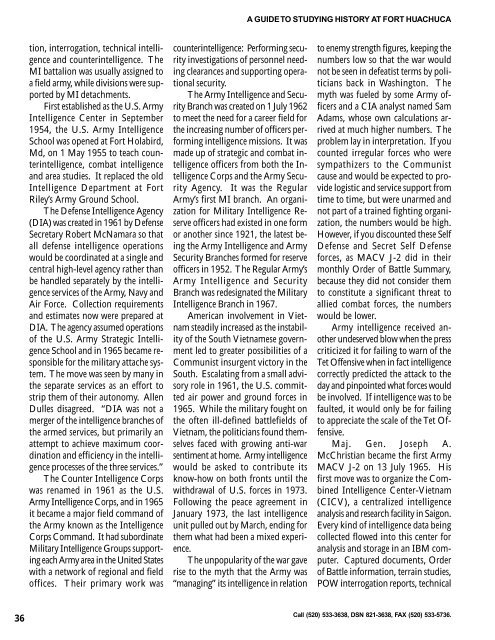Brief History of Army MI - Fort Huachuca - U.S. Army
Brief History of Army MI - Fort Huachuca - U.S. Army
Brief History of Army MI - Fort Huachuca - U.S. Army
You also want an ePaper? Increase the reach of your titles
YUMPU automatically turns print PDFs into web optimized ePapers that Google loves.
A GUIDE TO STUDYING HISTORY AT FORT HUACHUCAtion, interrogation, technical intelligenceand counterintelligence. The<strong>MI</strong> battalion was usually assigned toa field army, while divisions were supportedby <strong>MI</strong> detachments.First established as the U.S. <strong>Army</strong>Intelligence Center in September1954, the U.S. <strong>Army</strong> IntelligenceSchool was opened at <strong>Fort</strong> Holabird,Md, on 1 May 1955 to teach counterintelligence,combat intelligenceand area studies. It replaced the oldIntelligence Department at <strong>Fort</strong>Riley’s <strong>Army</strong> Ground School.The Defense Intelligence Agency(DIA) was created in 1961 by DefenseSecretary Robert McNamara so thatall defense intelligence operationswould be coordinated at a single andcentral high-level agency rather thanbe handled separately by the intelligenceservices <strong>of</strong> the <strong>Army</strong>, Navy andAir Force. Collection requirementsand estimates now were prepared atDIA. The agency assumed operations<strong>of</strong> the U.S. <strong>Army</strong> Strategic IntelligenceSchool and in 1965 became responsiblefor the military attache system.The move was seen by many inthe separate services as an effort tostrip them <strong>of</strong> their autonomy. AllenDulles disagreed. “DIA was not amerger <strong>of</strong> the intelligence branches <strong>of</strong>the armed services, but primarily anattempt to achieve maximum coordinationand efficiency in the intelligenceprocesses <strong>of</strong> the three services.”The Counter Intelligence Corpswas renamed in 1961 as the U.S.<strong>Army</strong> Intelligence Corps, and in 1965it became a major field command <strong>of</strong>the <strong>Army</strong> known as the IntelligenceCorps Command. It had subordinateMilitary Intelligence Groups supportingeach <strong>Army</strong> area in the United Stateswith a network <strong>of</strong> regional and field<strong>of</strong>fices. Their primary work wascounterintelligence: Performing securityinvestigations <strong>of</strong> personnel needingclearances and supporting operationalsecurity.The <strong>Army</strong> Intelligence and SecurityBranch was created on 1 July 1962to meet the need for a career field forthe increasing number <strong>of</strong> <strong>of</strong>ficers performingintelligence missions. It wasmade up <strong>of</strong> strategic and combat intelligence<strong>of</strong>ficers from both the IntelligenceCorps and the <strong>Army</strong> SecurityAgency. It was the Regular<strong>Army</strong>’s first <strong>MI</strong> branch. An organizationfor Military Intelligence Reserve<strong>of</strong>ficers had existed in one formor another since 1921, the latest beingthe <strong>Army</strong> Intelligence and <strong>Army</strong>Security Branches formed for reserve<strong>of</strong>ficers in 1952. The Regular <strong>Army</strong>’s<strong>Army</strong> Intelligence and SecurityBranch was redesignated the MilitaryIntelligence Branch in 1967.American involvement in Vietnamsteadily increased as the instability<strong>of</strong> the South Vietnamese governmentled to greater possibilities <strong>of</strong> aCommunist insurgent victory in theSouth. Escalating from a small advisoryrole in 1961, the U.S. committedair power and ground forces in1965. While the military fought onthe <strong>of</strong>ten ill-defined battlefields <strong>of</strong>Vietnam, the politicians found themselvesfaced with growing anti-warsentiment at home. <strong>Army</strong> intelligencewould be asked to contribute itsknow-how on both fronts until thewithdrawal <strong>of</strong> U.S. forces in 1973.Following the peace agreement inJanuary 1973, the last intelligenceunit pulled out by March, ending forthem what had been a mixed experience.The unpopularity <strong>of</strong> the war gaverise to the myth that the <strong>Army</strong> was“managing” its intelligence in relationto enemy strength figures, keeping thenumbers low so that the war wouldnot be seen in defeatist terms by politiciansback in Washington. Themyth was fueled by some <strong>Army</strong> <strong>of</strong>ficersand a CIA analyst named SamAdams, whose own calculations arrivedat much higher numbers. Theproblem lay in interpretation. If youcounted irregular forces who weresympathizers to the Communistcause and would be expected to providelogistic and service support fromtime to time, but were unarmed andnot part <strong>of</strong> a trained fighting organization,the numbers would be high.However, if you discounted these SelfDefense and Secret Self Defenseforces, as MACV J-2 did in theirmonthly Order <strong>of</strong> Battle Summary,because they did not consider themto constitute a significant threat toallied combat forces, the numberswould be lower.<strong>Army</strong> intelligence received anotherundeserved blow when the presscriticized it for failing to warn <strong>of</strong> theTet Offensive when in fact intelligencecorrectly predicted the attack to theday and pinpointed what forces wouldbe involved. If intelligence was to befaulted, it would only be for failingto appreciate the scale <strong>of</strong> the Tet Offensive.Maj. Gen. Joseph A.McChristian became the first <strong>Army</strong>MACV J-2 on 13 July 1965. Hisfirst move was to organize the CombinedIntelligence Center-Vietnam(CICV), a centralized intelligenceanalysis and research facility in Saigon.Every kind <strong>of</strong> intelligence data beingcollected flowed into this center foranalysis and storage in an IBM computer.Captured documents, Order<strong>of</strong> Battle information, terrain studies,POW interrogation reports, technical36Call (520) 533-3638, DSN 821-3638, FAX (520) 533-5736.
















